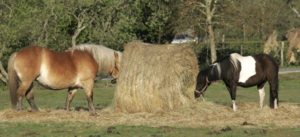 Feeding Preserved Forage to Horses: If you had the chance to feed your horse better for optimal health, behavior, and performance, what would you do? A recent article addresses the fact that many horses are fed based on historical trends rather than modern conditions.
Feeding Preserved Forage to Horses: If you had the chance to feed your horse better for optimal health, behavior, and performance, what would you do? A recent article addresses the fact that many horses are fed based on historical trends rather than modern conditions.
Equine diets were significantly altered with domestication, according to the authors of the article*. Horses were once recruited as beasts of burden. They were far too busy to graze fresh pasture for the majority of the day. Instead, owners fed oats, barley, beans, and root vegetables to provide sufficient energy for work. Offering preserved forage such as hay was more difficult in those days due to the challenges associated with the distribution and transport of bulky forages in addition to concerns regarding the quality of forage.
Now, many horses continue to receive preserved forages—including hay, haylage, and silage—rather than having access to fresh pasture. Even with the dramatically reduced workload compared to past times, some horses are still fed too many energy-dense feedstuffs (concentrates) and insufficient preserved forage or fresh pasture, despite the availability of quality forage that can often negate the need for excess concentrates.
Recommendations were made in reference to feeding preserved forage based on a comprehensive review of the literature and information garnered during conferences and nutrition workshops.
Recommendations:
- Perform nutrient analysis to appreciate the value of the forage and estimate the energy content. This is especially true for thin, overweight, and laminitic horses, or those with metabolic conditions.
- Routinely inspect the hay to ensure no hygiene issues exist (e.g., growth of molds that can negatively impact horse health). Dispose of poor-quality forage.
- Any substantial changes in forage quality in terms of energy, protein, and water-soluble carbohydrate content requires a two- to three-week acclimation period.
- Offer fresh or preserved forage with stem length greater than one inch (2.5 cm) ad libitum throughout the day.
- Horses should be consuming feed (hay or concentrate) for a minimum of 8-10 hours/day, with a maximum of 4-5 hours without food.
- If a horse requires more energy, use less mature forages.
- Consider introducing small amounts of chaff into the diet, if less energy is required (maximum of 30% of the dry matter ration).
“Note that these recommendations apply to healthy horses with an ideal body weight and no underlying medical condition. Although these suggestions are useful generalizations, every horse is unique and must be fed individually. Tailor your horse’s diet to meet his needs. For example, consider consulting with one of the nutrition advisors at Kentucky Equine Research,” advised Kathleen Crandell, Ph.D., a nutritionist for KER.
Offer a well-formulated vitamin and mineral supplement. Especially for horses on diets composed entirely of forage.
Do you have question about Feeding Preserved Forage to Horses? Contact us at J & J Hay Farms by clicking here!
Article Sources:
Harris, P.A., A.D Ellis, M.J. Fradinho, et al. Feeding conserved forage to horses: Recent advances and recommendations. Animal 11:958-967.
